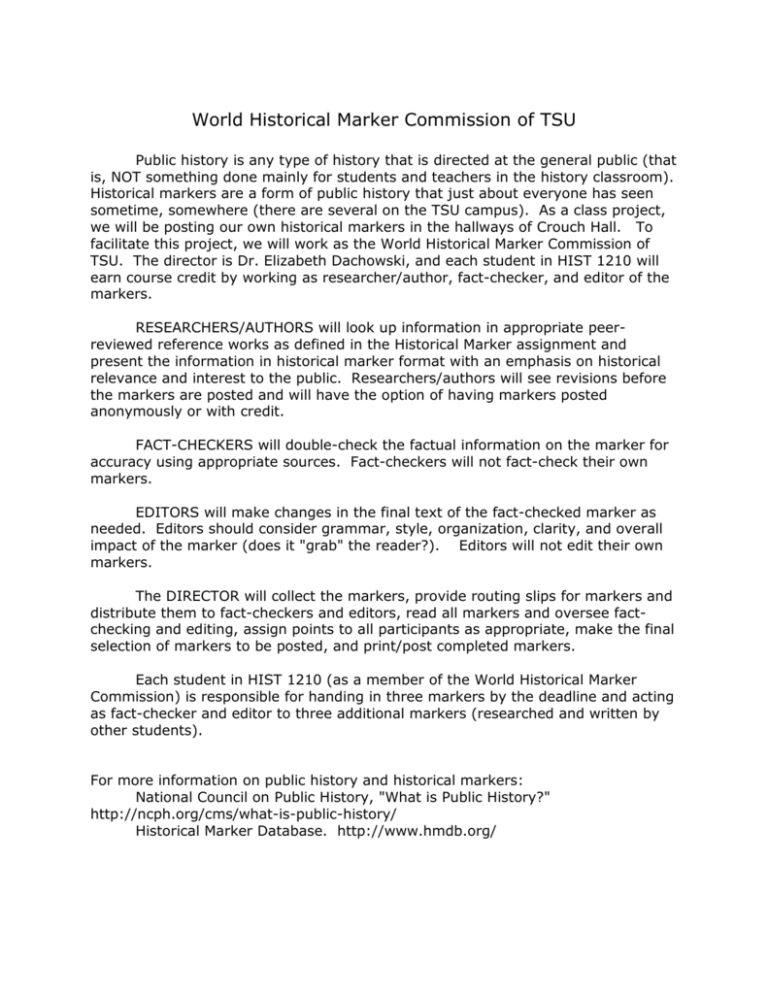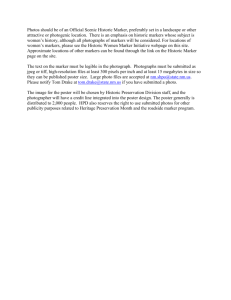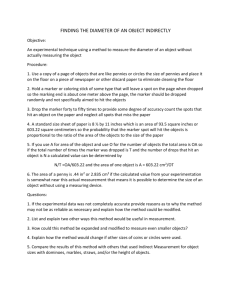Historical markers
advertisement

World Historical Marker Commission of TSU Public history is any type of history that is directed at the general public (that is, NOT something done mainly for students and teachers in the history classroom). Historical markers are a form of public history that just about everyone has seen sometime, somewhere (there are several on the TSU campus). As a class project, we will be posting our own historical markers in the hallways of Crouch Hall. To facilitate this project, we will work as the World Historical Marker Commission of TSU. The director is Dr. Elizabeth Dachowski, and each student in HIST 1210 will earn course credit by working as researcher/author, fact-checker, and editor of the markers. RESEARCHERS/AUTHORS will look up information in appropriate peerreviewed reference works as defined in the Historical Marker assignment and present the information in historical marker format with an emphasis on historical relevance and interest to the public. Researchers/authors will see revisions before the markers are posted and will have the option of having markers posted anonymously or with credit. FACT-CHECKERS will double-check the factual information on the marker for accuracy using appropriate sources. Fact-checkers will not fact-check their own markers. EDITORS will make changes in the final text of the fact-checked marker as needed. Editors should consider grammar, style, organization, clarity, and overall impact of the marker (does it "grab" the reader?). Editors will not edit their own markers. The DIRECTOR will collect the markers, provide routing slips for markers and distribute them to fact-checkers and editors, read all markers and oversee factchecking and editing, assign points to all participants as appropriate, make the final selection of markers to be posted, and print/post completed markers. Each student in HIST 1210 (as a member of the World Historical Marker Commission) is responsible for handing in three markers by the deadline and acting as fact-checker and editor to three additional markers (researched and written by other students). For more information on public history and historical markers: National Council on Public History, "What is Public History?" http://ncph.org/cms/what-is-public-history/ Historical Marker Database. http://www.hmdb.org/ Assignment Write three historical markers (one for each major period covered by the course). Upload your marker into the D2L (elearn) dropbox for the assignment. Due dates and topics are indicated below. You have been given the job of writing a historical marker for a significant place in world history. Compose a text (entirely in your own words) that is historically accurate, full of interesting detail, grammatically correct, and no longer than 150 words. The focus of your marker should be on the time period covered in the course (before 1500 CE). Your historical marker assignment should include the following sections: (1) Text of the marker. Required elements are a brief description of the historical site/object (remember that marker readers are generally able to see the site, so keep this to a sentence and/or focus on things not necessarily visible), historical context (what was going on in that place generally, such as religious movement, establishment of an empire, etc.), specific historical details relevant to the site, and historical significance. Put information entirely in your own words. Try to avoid quotations since the marker format doesn't facilitate giving citations, EXCEPT you are encouraged to quote briefly from primary sources if relevant. (2) Full citation (Chicago Manual of Style) of all sources used. You may use ONLY your textbook (cite specific chapter) and articles in the collection Oxford Reference Online Premium (available on the eBooks page of the TSU library; password required for off-campus access). If you wish to use any other sources, you must get written permission from the instructor (email edachowski@tnstate.edu) at least 48 hours before the assignment is due and attach a copy of your correspondence to the assignment. Your fact-checker and the director will be looking to make sure that the information you include is supported by your sources, so include in the text of the marker ONLY information that you found in your sources and include in the citation section ALL sources used. If there is a disconnect between sources cited and the information in the marker text, you will be severely penalized. Your editor and the director will be looking to make sure that the form of the citation is correct. (3) Process paragraph: This should be a brief discussion of the choices that you made in deciding what to include in the marker text. Things to include might be your decision to leave out some information (not enough room on the marker), you decision to include other information, things that you wanted to add but couldn't find information about (for example, if you wanted to give the population of a city but couldn't get that info), and any surprises along the way (either good or bad surprises; for example, there was a name that could be spelled several different ways, which made looking it up difficult, or if you found out something cool you didn't know before or if your sources gave seemingly contradictory information). Grading will be as follows: Each marker will be worth 10% of your final grade and graded on a 10-point scale. The text of the marker will be worth 4 points, the citations 3 points, and the process paragraph 3 points. Late markers will be penalized a point a day up to a maximum deduction of 5 points out of 10. Your participation grade will be based on your being a good team player in this assignment. To gain full credit you must (1) hand in all markers by the deadline (otherwise the editors and fact-checkers can't get to work), (2) complete your fact-checking on time, (3) complete your editing on time, (4) comment on and/or accept suggested revisions to your own marker. Fact-checking and editing will be worth 5% each (for a total of 10% of your course grade). To receive full credit, you must do a fair and honest job with the markers assigned to you and hand back your work in a timely manner. Note that no markers will be assigned to you until you hand in your marker (and if you are excessively late doing this, you may not get assigned any markers and thus forfeit these points). You will receive a 1-point extra-credit bonus for each marker which is approved for posting (maximum of 3 extra credit points for the semester). First Marker (choose ONE and focus on the period before 500 BCE) Marker due: Sept 10 . Fact-checking and editing due: Sept 19. Revisions due: Sept 26. Lascaux Cave Great Sphinx of Giza (also Sphinx of Khafre or Sphinx of Khufu) city of Babylon Knossos (on the island of Crete; also Cnossos) Harappa San Lorenzo Second Marker (choose ONE and focus on the period 500 BCE to 500 CE) Marker due: Oct 10. Fact-checking and editing due: Oct 24. Revisions due: Oct 31. Meroë (African city) Forum Augustum (also Forum Augusti; hint: Octavian/Augustus Caesar) Tomb of Shihuangdi Silk Road Parthenon (the one in Athens, not Nashville!) Library of Alexandria Varanasi (also Benares) Third Marker (choose ONE and focus on the period 500-1600 CE) Marker due: Nov 19. Fact-checking and editing due: Nov 26. Revisions due: Dec 5. Baghdad Lübeck Teotihuacan Angkor Wat Timbuktu Kilwa







